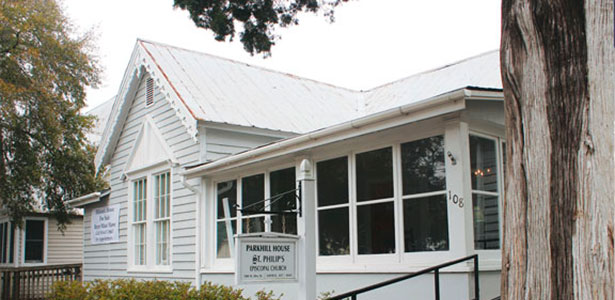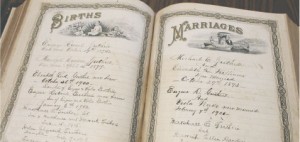History Well-Kept: The Parkhill House is ‘for sale’ at any reasonable offer, with one condition

There’s a trend on the social media sites of home and garden magazines: stories about buildings that are “for sale” at unbelievable prices. Country Living shared a story about a castle that was available for only one dollar, but had to be moved from the lot it’s currently sitting. Another site reported a woman is selling her Maine inn for a very small amount and a 250-word essay.
In downtown Southport, a similar opportunity arose just a few months ago. An historic home built in 1886 that is now part of the property of St. Philip’s Episcopal Church is “for sale” at any reasonable offer with only one condition the house must be moved off its current site.

Tommy Harrelson, author of “Southport’s Art Newton,” was close friends with Elizabeth Robinson who once lived in the home her grandfather, M.C. Guthrie built. Harrelson, as a member of St. Philip’s, understands the church’s need for space but he and Interim Rector Rev. Betty Glover hope to save the house by selling it to someone willing to move it.
“Our church is growing and we have a very small parish hall,” Harrelson explains. “It was here when my parents went to church here, but it was much smaller then. Now we have 600 members. We just need the space for church receptions, after gatherings, funerals, weddings, meals together. Our desire is that someone take this house, move it, and restore it. We’re open to any reasonable offers. We’re not trying to make money off of it; we just want it to be preserved.”

The home, known as the Parkhill House, is located at 108 N. Dry Street beside the church. In 1979 Carl Lounsbury describe the house in “The Architecture of Southport”: “Small onestory building built in 1886 for M.C. Guthrie, a proprietor of Guthrie and Ruark, a dry goods and general merchandise store which was located just south of Guthrie’s house on the northeast corner of Moore and Dry streets. Notable features on the exterior are the decorative jigsawed barge boards on the three gables. In plan, the house consisted originally of four rooms arranged in a cross plan, the largest room being parallel to the street and opening into the other three rooms.”
Indeed, the seagulls and crows of Southport know the cross plan well. From the sky, or from Google Earth, one can easily view the home laid into the shape of a cross. Inside, the cross plan allows the rooms to float around the center of where life takes place: in the living room, next to the fireplace. And from the outside, the soft gray home can only be described in one word.
“Isn’t it sweet?” Harrelson muses as I first encounter the Parkhill House.
From the bay window to the screen porchand especially because of the gables and roofthis home is nothing short of sweet. It possesses a captivating charm and harkens back to Southport’s former life. “It’s got all the typical Southport architecture,” Harrelson adds, noting the requisite Southport bows above the doorways and windows on the interior. “And it’s a very graceful house. I think it’s a beautiful cottage. Too many houses here have been torn down. Lots of houses have been moved, but too many have just been torn down. It’s part of the history of the town to have this architecture and these old houses.”
As for moving buildings, Harrelson is no stranger to the concept. He’s renovated five and moved three houses. “The renovation is something. The moving of the house is not a big deal,” he assures. “There are all kinds of ways to do it, whether cutting it and putting it back together on site or removing the roof and adding it on the new site. It has good bones. We’ve had house movers look at it, underneath it, and they say it can be moved.”

The renovation will be up to the new owner. They may leave the house asis, or depending on the level of use, may wish to update it. “The owner would be someone who likes old houses, charming houses,” Harrelson notes. “Prominent people lived here. There was a store on this corner of Moore and Dry streets that was owned by Mr. Guthrie, who was Elizabeth’s dad, and Mr. Ruark, Elizabeth’s husband was a Coast Guardsmen, and then he rose to be mayor of Southport. She was the queen of Southport for a while.”
Harrelson knew Elizabeth Robinson very well. “She was a character. She was an old lady full of wit,” he describes. “She loved politics. I’m a Republican and she was a staunch Democrat, but we were still very good friends. She was a prominent citizen that Democrats would come see and seek support from. She would give them her advice and either support them or not. She loved people to come see her like that. She was a witty, witty woman.”

Though Elizabeth never had any children, she and her husband, Captain Roy Robinson, lived in the home. “She was raised in this house. She was part of St. Philip’s Church. Upon her death she left the house to the current mayor of Southport, Robert Howard, and he sold it to us,” Harrelson explains.
Harrelson, a lover of Southport history and a storyteller by nature, shares many anecdotes of Elizabeth’s sharp mind and quick humor. The tales leave Rev. Glover and me wishing we had the chance to meet her ourselves. One quote from the former “Queen of Southport” stuck with me, as she once told her friend, “The trouble with me is, I count to 10 and I still say it.”


In another renovated old home in downtown Southport, Harrelson was able to rescue the Guthrie family Bible and other historic documents, as they were being held in storage for Elizabeth’s mother but were forgotten. The Bible holds records of the family’s history, it’s binding now falling apart. As we delicately turned the pages of time, Rev. Glover pulled out an old parish register dating back to 1867. “The church was the holder of the history,” she says. “I think it’s interesting because we don’t look at this stuff anymore. As we get so ‘fast,’ we forget. I think that’s the treasure of this kind of record, that we just don’t have them anymore.”
Indeed, as our lives become more digital, the old ways of maintaining recordstangible items our ancestors touched that our posterity can treasurewell, they just don’t exist. “The county needs to have a depository for these things,” Harrelson urges. “Wilmington has a wonderful selection of their local history and these types of books that they keep. Somehow, we’re not preserving it in this county. I wish that between the community college and the library system, somebody could come up with money to fund a depository for historic documents.”
“I just think we have fewer and fewer of the things that show where we’ve been, where we are, and could show where we’re going,” Rev. Glover suggests. “If we don’t preserve these kinds of structures, we lose a part of our history that we don’t ever get back. We can take pictures, and we have records, but there’s something about being able to look at a structure like this. When I sit in my office I wonder about the people who have come through those doorsespecially when you consider the kind of property that it sits on. I just think that we are stewards of our history, our present and our future, and this is one way to think about keeping that intact. If it’s just razed, then we lose it, and I think it’s a tragedy.”
For details about viewing or bidding on the home, visit www.stphilipschurch.org or call (910) 2790511 to reach William Bittenbender, the chair of the Master Planning Committee. Bittenbender is a licensed North Carolina real estate broker representing St. Philip’s Church without compensation. Bids must be received by mid to late April.











Am very interested in the Parkhill House, if it is still available, to move it to a lot on Caswell St. in the village. Please advise if home is still available.
The only information I have is the contact information in the article – “For details on the home, visit http://www.stphilipschurch.org or call (910) 279 – 0511 to reach William Bittenbender, the chair of the Master Planning Committee. Bittenbender is a licensed North Carolina real estate broker representing St. Philip’s Church without compensation.” I’m sure you can get answers there. It is such a neat place! Good luck! Jennifer